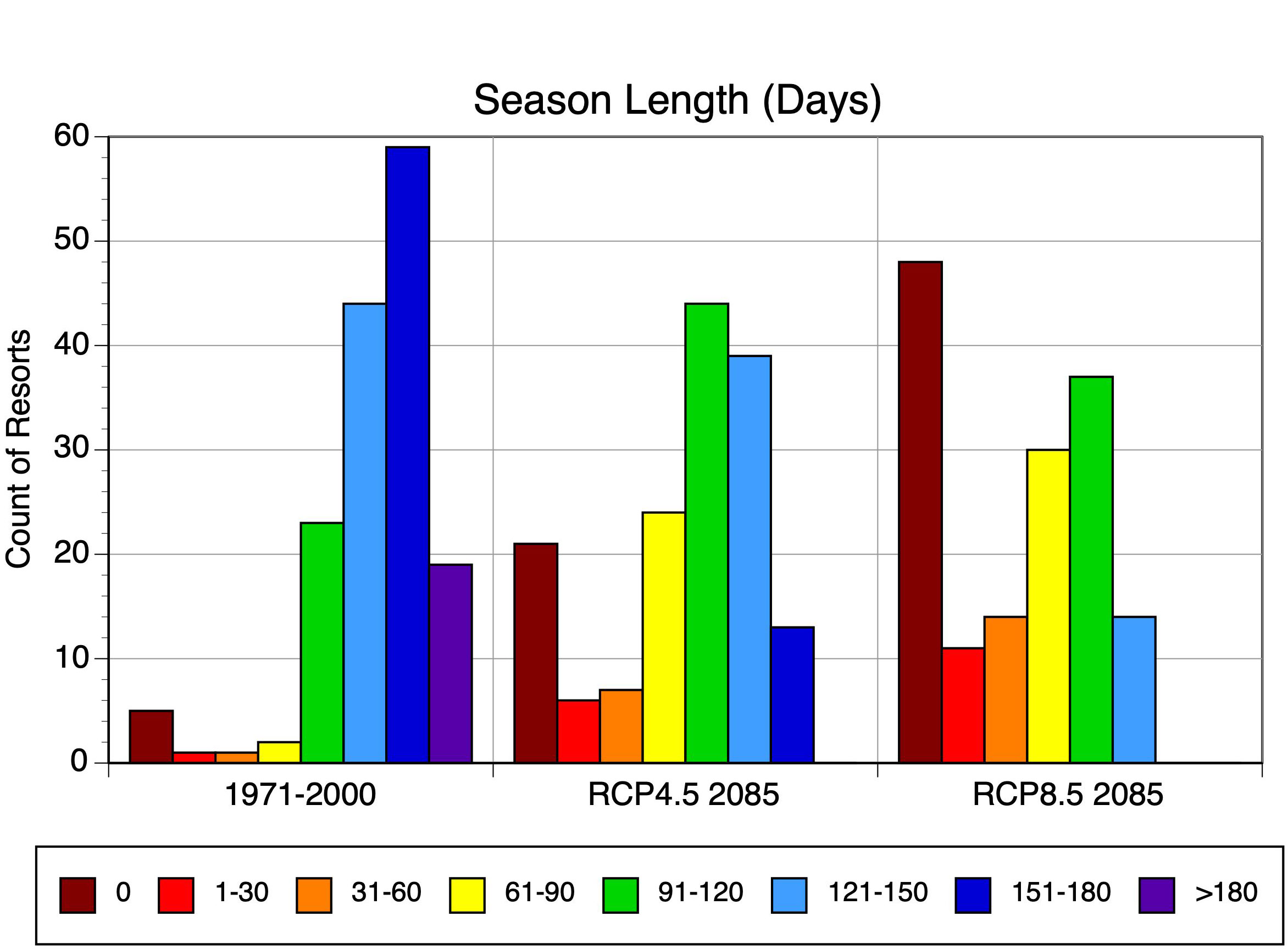by ETHAN CLARK and MICHAEL PIDWIRNY
Objectives
The purpose of our research was to determine the impact of future climate change on the length of the ski season for 154 selected resorts in Western North America. This research uses climate databases ClimateBC and ClimateNA to produce high quality historical data and future predicted data from 15 global climate models (GCMs). Using monthly temperature data, we were able to model the length of ski season at each resort’s mid-elevation for the normal period 1971-2000 and two emission scenarios, RCP4.5. (best-case scenario) and RCP8.5 (worst-case scenario), for the year 2085.
Introduction
Several studies have suggested that the winter recreational activities of skiing and snowboarding will be severely impacted by changes in temperature and precipitation driven by future human caused climate change. Skiing and snowboarding are activities normally done in the winter season when temperatures are below freezing and precipitation falls as snow. Climate change should cause the length of the ski season to shorten, mainly controlled by warming temperatures. This research uses monthly temperature to model the changes in ski season length for 154 ski resorts in Western North America under RCP4.5 and RCP8.5 emission scenario to the year 2085.
Methods
1) We identified 154 major ski resorts in Western North America and determined their mid-elevation using OntheSnow.com.
2) Using Google Earth for each ski resort we determined their exact decimal degree latitudinal and longitudinal location (to 4 decimal points) for a point on the resort that was at mid-elevation and roughly at its geographic center.
3) Climate databases ClimateBC and ClimateNA (Wang et al., 2016) were used to generate statistically downscaled, spatially interpolated, and altitude adjusted historical monthly mean temperature data for the thirty years between 1971-2000.
4) ClimateBC and ClimateNA were also used to produce future forecasted monthly mean temperature data for the year 2085 under RCP4.5 and RCP8.5 emission scenarios for 15 different GCMs used in the IPCC’s 5th Assessment Report.
5) For each ski resort, daily mean temperature curves were constructed using polynomial regression from the monthly data for the average of 1971-2000 and for the average of 15 GCM results for both RCP emission scenarios.
6) Ski season length (number of days) was calculated from the daily mean temperature curves using a 0°C threshold.
7) A Geographical Information System was used to map the ski season length of each resort for the historical average of 1971-2000, RCP4.5 2085, and RCP8.5 2085. To simplifying the map display, ski season length was grouped as being either 0 days, 1-30, 31-60, 61-90, 91-120, 121-150, 151-180, and greater than 180 days for the resorts studied.
Results
Figures 1, 2 and 3 display the calculated ski season length of each ski resort for the historical normal of 1971-2000, RCP4.5 2085, and RCP8.5 2085, respectively. Figure 4 shows the same data in three histograms.

Figure 1. Length of ski season under 1971-2000 period for selected ski resorts in Western North America.

Figure 2. Length of ski season under RCP4.5 for 2085 for selected ski resorts in Western North America.

Figure 3. Length of ski season under RCP8.5 for 2085 for selected ski resorts in Western North America.

Figure 4. Distribution of binned length of ski season data for 1971-2000 normal, and RCP4.5 and RCP8.5 emission scenarios for 2085.
Discussion and Conclusions
The spatial distribution of season length at Western North American ski resorts shows there is a clear difference between coastal versus continental resorts in the climate normal period and both RCP4.5 and RCP8.5 emission scenarios (Figures 1, 2 and 3). Resorts close to the coast are moderated in temperature by the Pacific Ocean leading to shorter ski seasons. Interior resorts experience the effect of continentality which causes colder winter temperatures and longer ski seasons.
The histograms in Figure 4 show a dramatic shift in season lengths from 1971-2000 to future scenarios. During the historical period, only five ski resorts were calculated to have no definable ski season. These resorts are found in California and they operate only under ideal conditions. For the future forecast, the number of ski resorts with no definable ski season increases to 21 and 48 for the RCP4.5 and 8.5 emission scenarios, respectively. The resorts with no definable ski season are located in close proximity to the North American coast. Removing resorts with no ski season, we calculate the average ski season length to be 153 days for the 1971-2000 climate normal period, 108 days for RCP4.5, and 83 days for RCP8.5.
For many ski resorts in Western North America, the heart of ski season currently runs from the beginning of December to the end of March or approximately 120 days. For the 1971-2000 climate normal period, our analysis indicates that 79% of the resorts we studied have a season length of 120 days or greater. Our future forecast suggests that resorts with a season length of 120 days or greater decreases to 34% with RCP4.5 and only 9% under RCP8.5 by 2085.
While both emission scenarios will cause significant decreases in ski season length, the best-case RCP4.5 scenario is clearly a better outcome. This stresses the importance for ski resorts and other winter sports stakeholders to be active lobbyists against future climate change through the reduction greenhouse gases emissions.
References
Wang, T., A. Hamann, D. Spittlehouse and C. Carrol 2016. Locally downscaled and spatially customizable climate data for historical and future periods for North America. PLos ONE 11(6) doi:10.1371/journal.pone.0156720.